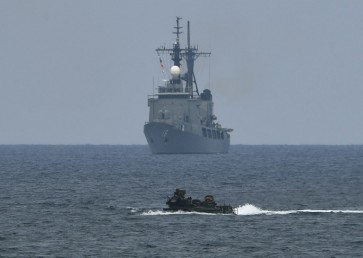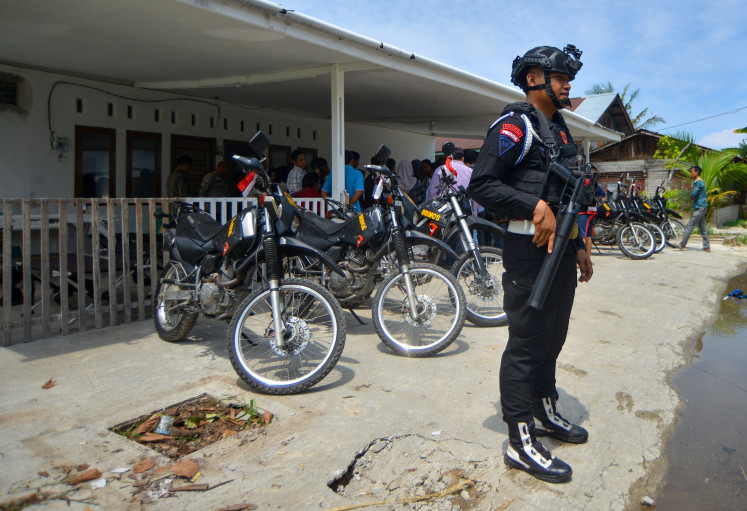Popular Reads
Top Results
Can't find what you're looking for?
View all search resultsPopular Reads
Top Results
Can't find what you're looking for?
View all search resultsAmbon’s unspoiled underwater world
Tiga IslandFor many divers, an encounter with a turtle may be an ordinary thing
Change text size
Gift Premium Articles
to Anyone
Tiga Island
For many divers, an encounter with a turtle may be an ordinary thing. But for me, getting up close with the creature when diving in Ambon’s underwater world was a dream come true.
The turtle was swimming lazily in the Batu Lompa dive site in Ambon. The rare sight made me stop kicking my fins and my heart skipped a beat until the turtle swam further away seconds later.
I was then entertained by a school of long fin banner fish and a dancing lionfish that tried to make its way out of a huge vase-shaped sponge.
Batu Lompa is one of the 21 diving sites in Ambon where divers can frequently see turtles. With excellent visibility — about 15 meters horizontally and 20 meters vertically — the site’s seabed is mainly covered with sand and rocks.
Divers make their way out of Hukurila cave.
My dive master, Franky, led our group and pointed to his right. We followed his direction and saw bubbles coming out of the sandy bottom and rocks. Batu Lompa is famous for its volcanic dive site.
While we were busy taking pictures of the volcanic bubbles, another surprise greeted us. A school of one-meter long barracuda came before our eyes, swimming around the bubbles, as if asking to be captured in the lens.
After diving for about an hour, my group of six decided to call it a day as we’d almost ran out of air in our tanks. Slowly, we ascended to the surface and shared what we had seen underwater.
Frogfish in Laha muck dive site.
Just like the city’s tagline — Ambon Manise (the Sweet Ambon) — its underwater is so sweet and rich, it’s sure to fascinate every diver visiting the island, which is part of a volcanic island chain that forms a circle around the Banda Sea. The island’s shape, which seems almost split into two, has formed unique underwater topography.
The capital of Maluku has two main bays — Ambon and Baquala. Ambon Bay is around 12 miles long. Underneath, it holds several underwater caverns and huge walls.
Hukurila Cave is one of the most visited dive sites in Ambon. The thrill of making an entrance to the cave enhances the sensation of Ambon’s underwater experience since divers must first enter the 1.5 meter “gate” located about 10 meters from the surface.
School of barracuda
Huge red, pink and orange sea fans as well as various sponges and whip corals decorate the cavern’s walls, making it a perfect site for underwater photographers.
“The corals are in good condition, untouched and bleach-free,” said Leng, a diver from Singapore who joined the group.
The warm water temperature of around 29 degrees Celsius, the shallow current, the sunlight that illuminates the underwater inhabitants and the clear visibility of around 20 meters make the dive in Hukurila Cave an intriguing dive site.
Beside caverns, Ambon also offers a world-class muck dives at its Laha site.
Lion fish comes out of vase sponge.
“Ambon is like Lembeh [in North Sulawesi], which is famous for muck dives. One can dive at the dirty bay filled with thrash and at the same time, find frogfish, nudibranch, rhinopias, mandarin fish, octopus, dragonet and many more exotic critters,” Leng said.
Unique underwater topography is not the only thing that makes Ambon a must-visit dive site in eastern Indonesia. Down under, divers can also find a shipwreck lying beneath the ocean surface.
The 137-meter-long ship, believed to be a Dutch cargo vessel, sank in Ambon Bay in the 1950s reportedly after being bombed by the Americans during the so-called Operation Haik.
Moray eel
The shallowest part of the fully intact ship is found at around 12 meters while the deepest is at around 37 meters. Despite the moderate visibility of around 5 to 10 meters, the shipwreck is now home to many kinds of soft and hard corals and different fish.
And to get the real diving taste in Ambon, divers can choose between two dive operators on the island: Blue Rose Divers in Latuhalat, where I stayed, and Maluku Divers in Laha.
The best time to go is between October and May, when the sea is flat and the weather is clear. Despite its easy access and the various options it offers, only a handful of divers were seen in Ambon during my stay, making the sites unspoiled and exclusive.
“Ambon is among the top three dive sites I want to visit,” said Michael Fong, a diver from Hong Kong. “It’s extraordinary and untouched. Not so many people go diving here yet, I guess.”
— Photos by Erlangga Mahardika —















